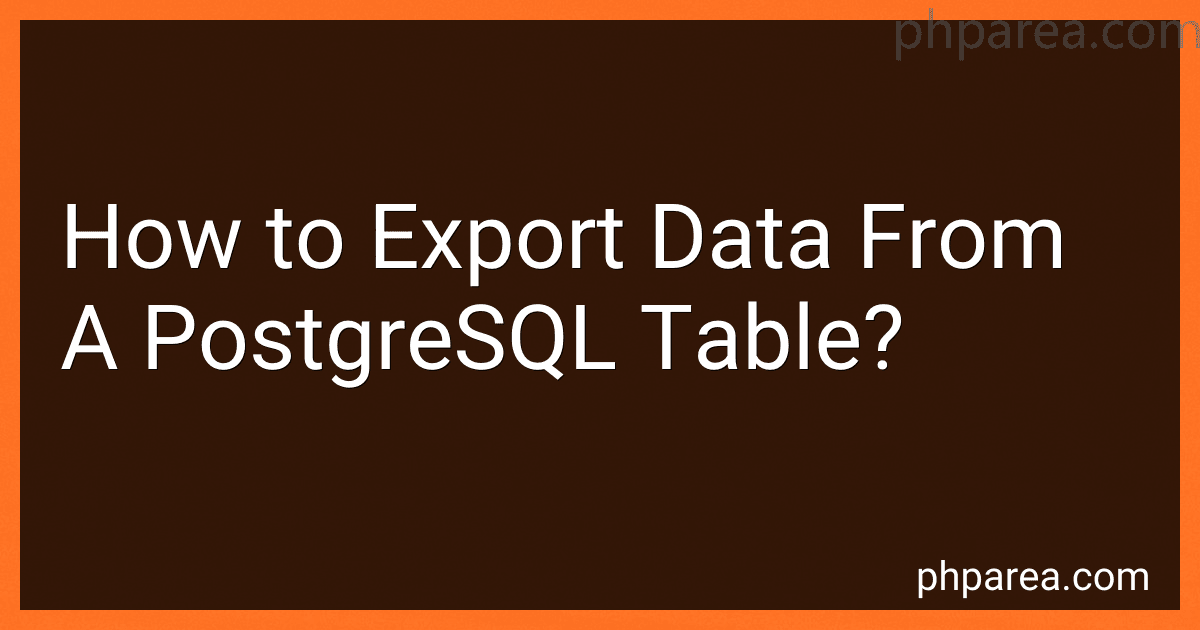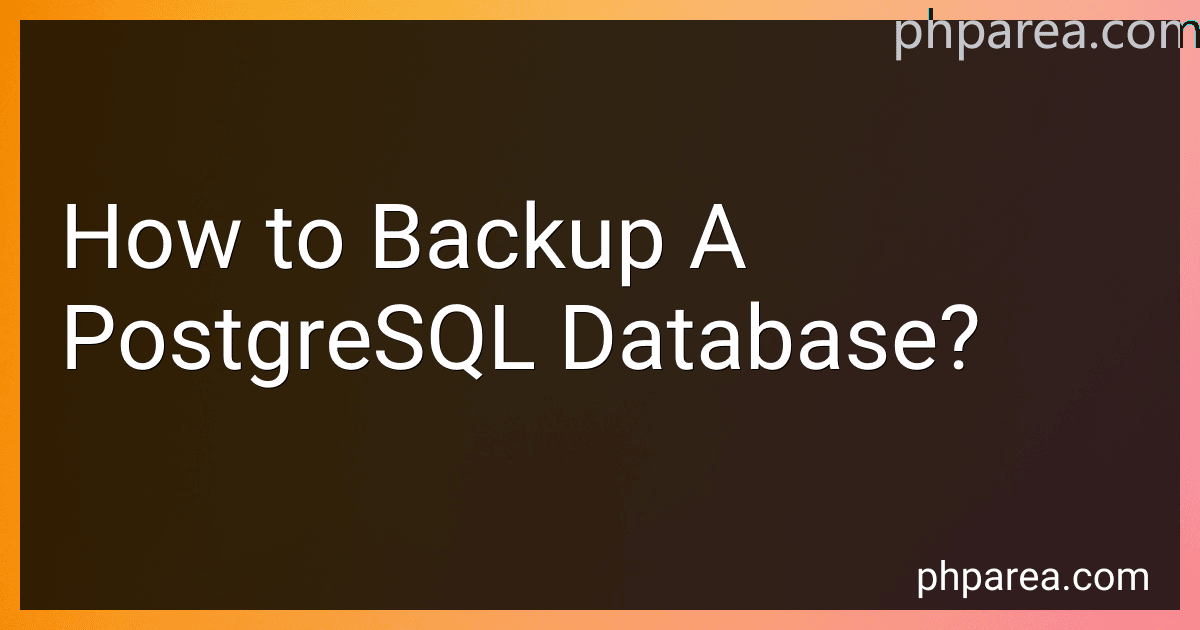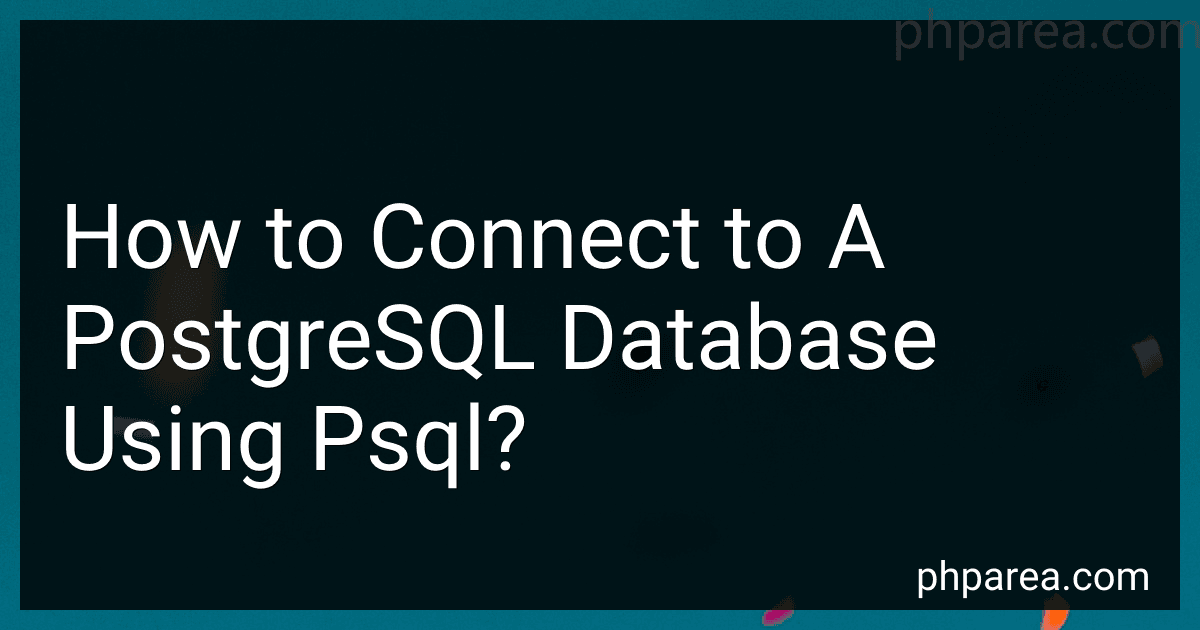Posts (page 47)
-
 6 min readTo export data from a PostgreSQL table, you can use the "COPY" command in the psql utility or use the pgAdmin graphical interface. In psql, you can execute a command like "COPY table_name TO 'file_path.csv' CSV;" to export the data from a specific table to a CSV file. In pgAdmin, you can right-click on the table, select "Backup," choose the format for the export (e.g., CSV, SQL, or other formats), and specify the file path for the export.
6 min readTo export data from a PostgreSQL table, you can use the "COPY" command in the psql utility or use the pgAdmin graphical interface. In psql, you can execute a command like "COPY table_name TO 'file_path.csv' CSV;" to export the data from a specific table to a CSV file. In pgAdmin, you can right-click on the table, select "Backup," choose the format for the export (e.g., CSV, SQL, or other formats), and specify the file path for the export.
-
 5 min readTo import data into a PostgreSQL table, you can use the COPY command. This command allows you to copy data from a file or program into a PostgreSQL table.First, you need to ensure that the data you want to import is in a proper format, such as CSV or TSV.
5 min readTo import data into a PostgreSQL table, you can use the COPY command. This command allows you to copy data from a file or program into a PostgreSQL table.First, you need to ensure that the data you want to import is in a proper format, such as CSV or TSV.
-
 5 min readTo enable HTTPS on XAMPP, you will first need to generate a self-signed SSL certificate. You can do this by using OpenSSL or a tool like KeyStore Explorer. Once you have the SSL certificate and key files, you will need to configure the Apache server in XAMPP to use HTTPS.This can be done by editing the Apache configuration file (httpd.conf) to include the paths to your SSL certificate and key files.
5 min readTo enable HTTPS on XAMPP, you will first need to generate a self-signed SSL certificate. You can do this by using OpenSSL or a tool like KeyStore Explorer. Once you have the SSL certificate and key files, you will need to configure the Apache server in XAMPP to use HTTPS.This can be done by editing the Apache configuration file (httpd.conf) to include the paths to your SSL certificate and key files.
-
 6 min readTo restore a PostgreSQL database from a backup, you can use the pg_restore utility provided by PostgreSQL. Start by creating a new empty database to restore the backup into. Then, use the pg_restore command followed by the path to your backup file and the name of the new database. You may also need to provide the username and password for the PostgreSQL user that has the appropriate permissions.
6 min readTo restore a PostgreSQL database from a backup, you can use the pg_restore utility provided by PostgreSQL. Start by creating a new empty database to restore the backup into. Then, use the pg_restore command followed by the path to your backup file and the name of the new database. You may also need to provide the username and password for the PostgreSQL user that has the appropriate permissions.
-
 6 min readTo install Node.js or npm on XAMPP, you will need to download the Node.js installer from the official website and run it to install Node.js on your system. Once Node.js is installed, npm (Node Package Manager) will also be installed along with it. After the installation is complete, you can open the XAMPP Control Panel and start the Apache server to run Node.js applications on your local server. You can then test your Node.
6 min readTo install Node.js or npm on XAMPP, you will need to download the Node.js installer from the official website and run it to install Node.js on your system. Once Node.js is installed, npm (Node Package Manager) will also be installed along with it. After the installation is complete, you can open the XAMPP Control Panel and start the Apache server to run Node.js applications on your local server. You can then test your Node.
-
 6 min readTo backup a PostgreSQL database, you can use the pg_dump command line utility. This tool allows you to create a complete backup of a specific database or specific tables within a database.To backup a PostgreSQL database using pg_dump, you first need to access the command line interface on your server. Once you are in the command line, you can use the pg_dump command followed by the name of the database you want to backup.
6 min readTo backup a PostgreSQL database, you can use the pg_dump command line utility. This tool allows you to create a complete backup of a specific database or specific tables within a database.To backup a PostgreSQL database using pg_dump, you first need to access the command line interface on your server. Once you are in the command line, you can use the pg_dump command followed by the name of the database you want to backup.
-
 5 min readTo install ldap2 using XAMPP, you first need to download the ldap2 extension for PHP. Once you have the extension downloaded, you need to extract the files and copy the LDAP2.dll file into the "ext" directory in your XAMPP installation folder.After copying the LDAP2.dll file, you need to open the php.ini file in the "php" directory of your XAMPP installation. In the php.ini file, you need to add the following line: "extension=ldap2.
5 min readTo install ldap2 using XAMPP, you first need to download the ldap2 extension for PHP. Once you have the extension downloaded, you need to extract the files and copy the LDAP2.dll file into the "ext" directory in your XAMPP installation folder.After copying the LDAP2.dll file, you need to open the php.ini file in the "php" directory of your XAMPP installation. In the php.ini file, you need to add the following line: "extension=ldap2.
-
 3 min readTo grant privileges to a user in PostgreSQL, you can use the GRANT statement followed by the specific privileges you want to grant, such as SELECT, INSERT, UPDATE, or DELETE. You also need to specify the table or database object that the privileges apply to. Additionally, you need to specify the user or role that you are granting the privileges to.
3 min readTo grant privileges to a user in PostgreSQL, you can use the GRANT statement followed by the specific privileges you want to grant, such as SELECT, INSERT, UPDATE, or DELETE. You also need to specify the table or database object that the privileges apply to. Additionally, you need to specify the user or role that you are granting the privileges to.
-
 5 min readTo configure a Laravel site on localhost using XAMPP, you first need to install XAMPP on your computer. After installing XAMPP, start the Apache and MySQL services from the XAMPP control panel. Then, download and install Composer on your computer if you haven't already.Next, open a command prompt and navigate to the htdocs folder in the XAMPP directory.
5 min readTo configure a Laravel site on localhost using XAMPP, you first need to install XAMPP on your computer. After installing XAMPP, start the Apache and MySQL services from the XAMPP control panel. Then, download and install Composer on your computer if you haven't already.Next, open a command prompt and navigate to the htdocs folder in the XAMPP directory.
-
 6 min readTo create a user in PostgreSQL, you can use the CREATE USER statement followed by the username and password for the new user. You can also specify additional options such as SUPERUSER, CREATEDB, CREATEROLE, LOGIN, and PASSWORD.
6 min readTo create a user in PostgreSQL, you can use the CREATE USER statement followed by the username and password for the new user. You can also specify additional options such as SUPERUSER, CREATEDB, CREATEROLE, LOGIN, and PASSWORD.
-
 3 min readTo connect to a PostgreSQL database using psql, you need to have the PostgreSQL client tools installed on your machine. Once you have the client tools installed, open a terminal window and type the following command:psql -U username -d databaseReplace "username" with the username of the user you want to connect as and "database" with the name of the database you want to connect to.You will be prompted to enter the password for the specified user.
3 min readTo connect to a PostgreSQL database using psql, you need to have the PostgreSQL client tools installed on your machine. Once you have the client tools installed, open a terminal window and type the following command:psql -U username -d databaseReplace "username" with the username of the user you want to connect as and "database" with the name of the database you want to connect to.You will be prompted to enter the password for the specified user.
-
 4 min readTo run a React.js project with Router on XAMPP, you will first need to build your React project using a tool like create-react-app. Once your project is built, you can navigate to the build folder and copy all the files to the htdocs folder in your XAMPP directory.Next, you will need to make sure that your XAMPP server is running and navigate to localhost in your web browser to access your React project.
4 min readTo run a React.js project with Router on XAMPP, you will first need to build your React project using a tool like create-react-app. Once your project is built, you can navigate to the build folder and copy all the files to the htdocs folder in your XAMPP directory.Next, you will need to make sure that your XAMPP server is running and navigate to localhost in your web browser to access your React project.